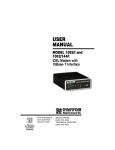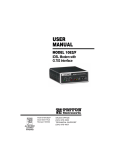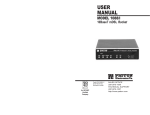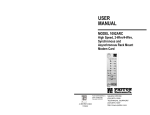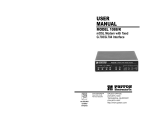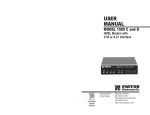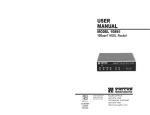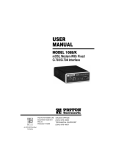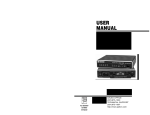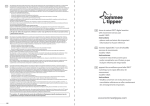Download Patton electronic 1082/144 Network Card User Manual
Transcript
USER MANUAL MODEL 1082 and 1082/144 iDSL Modem with V.34 or X.21 Interface Part# 07M1082/C-B Doc# 033151UB Revised 2/19/03 CERTIFIED An ISO-9001 Certified Company SALES OFFICE (301) 975-1000 TECHNICAL SUPPORT (301) 975-1007 TABLE OF CONTENTS 1.0 1.1 1.2 1.3 Warranty Information ................................................................. FCC Information ........................................................................... CE Notice...................................................................................... Service.......................................................................................... 4 4 4 5 2.0 2.1 2.2 2.3 General Information.................................................................... Features........................................................................................ Description.................................................................................... 1082 SNMP Management Solutions............................................. HTTP/HTML Management ........................................................... 6 6 6 7 7 3.0 3.1 Configuration .............................................................................. 8 Configuring the Hardware DIP Switches ...................................... 8 Configuring DIP Switch S1 ........................................................... 9 Switches S1-1 and S1-2: Data Rate........................................... 10 Switch S1-3: Data Set Ready during Line Loopback Test.......... 10 Switch S1-4: Must be set to the ON position (Reserved). .......... 11 Switch S1-5: Asynchronous/Sync Operation.............................. 11 Switches S1-6 and S1-7: System Clock Mode ........................... 11 Switch S1-8: Response to RDL Request.................................... 11 Configuring DIP switch S2.......................................................... 12 Switches S2-1: 19.2 kbps or 144 kbps Synchronous Rate Enable................................................................................ 13 Switch S2-2: Front Panel Switch Disable ................................... 13 Switches S2-3: Response to Local Line Loop Requests from DTE .................................................................... 13 Switches S2-4 and S2-5: Not Assigned...................................... 13 Switch S2-6: Response to RDL Request from DTE ................... 14 Switch S2-7: Compatability Mode............................................... 14 Switch S2-8: Not Assigned ......................................................... 14 4.0 4.1 4.2 Installation................................................................................. Connecting the Twisted Pair Interface........................................ Connecting the Model 1082 (V.35) Serial Interface.................... Connecting the Model 1082 (V.35) to a DTE Device.................. Connecting the Model 1082 (V.35) to a DCE Device ................. Connecting the Model 1082 (X.21) Serial Interface.................... Connecting the Model 1082 (X.21) to a “DCE” or “DTE” Device .............................................................................. Opening the Case....................................................................... Connecting Power ...................................................................... Universal AC Power (100–240VAC)........................................... DC Power ................................................................................... 15 15 16 16 16 17 Operation................................................................................... Power-up .................................................................................... LED Status Monitors................................................................... Test Modes ................................................................................. 21 21 21 22 4.3 4.4 5.0 5.1 5.2 5.3 2 17 18 19 19 20 Local Line Loopback (LLB)......................................................... 22 Remote Digital Loopback (RDL)................................................. 23 Using the V.52 (BER) test pattern generator.............................. 24 A A.1 A.2 A.3 A.4 A.5 A.6 A.7 A.8 A.9 A.10 A.11 A.12 A.13 A.14 A.15 Model 1082 Specifications ....................................................... 25 Transmission Format ................................................................... 25 Transmission Line ....................................................................... 25 Clocking ...................................................................................... 25 Distance ...................................................................................... 25 Data Rates .................................................................................. 25 Diagnostics ................................................................................. 25 LED Status Indicators ................................................................. 25 Connectors ................................................................................. 26 Power .......................................................................................... 26 Temperature Range .................................................................... 26 Altitude ........................................................................................ 26 Humidity ...................................................................................... 26 Dimensions ................................................................................. 26 Weight ......................................................................................... 26 Line Interface .............................................................................. 26 B Model 1082C and 1082D Factory Replacement Parts and Accessories............................................................................... 27 C Model 1082C and 1082D Interface Pin Assignments............. 28 D Model 1082C and 1082D Interface Pin Assignments............. 29 E Model 1082C and 1082D Interface Pin Assignment............... 30 3 1.0 WARRANTY INFORMATION Patton Electronics warrants all Model 1082 and Model 1082/144 components to be free from defects, and will—at our option—repair or replace the product should it fail within one year from the first date of shipment. This warranty is limited to defects in workmanship or materials, and does not cover customer damage, abuse or unauthorized modification. If this product fails or does not perform as warranted, your sole recourse shall be repair or replacement as described above. Under no condition shall Patton Electronics be liable for any damages incurred by the use of this product. These damages include, but are not limited to, the following: lost profits, lost savings and incidental or consequential damages arising from the use of or inability to use this product. Patton Electronics specifically disclaims all other warranties, expressed or implied, and the installation or use of this product shall be deemed an acceptance of these terms by the user. 1.1 FCC INFORMATION This equipment has been tested and found to comply with the limits for a Class A digital device, pursuant to Part 15 of the FCC Rules. These limits are designed to provide reasonable protection against harmful interference when the equipment is operated in a commercial environment. This equipment generates, uses, and can radiate radio frequency energy and, if not installed and used in accordance with the instruction manual, may cause harmful interference to radio communications. Operation of this equipment in a residential area is likely to cause harmful interference in which case the user will be required to correct the interference at his own expense. If this equipment does cause harmful interference to radio or television reception, which can be determined by turning the equipment off and on, the user is encouraged to try to correct the interference by one or more of the following measures: • Reorient or relocate the receiving antenna • Increase the separation between the equipment and receiver • Connect the equipment into an outlet on a circuit different from that to which the receiver is connected 1.2 CE NOTICE The CE symbol on your Patton Electronics equipment indicates that it is in compliance with the Electromagnetic Compatibility (EMC) directive and the Low Voltage Directive (LVD) of the Union European (EU). A Certificate of Compliance is available by contacting Patton Technical Support. 4 1.3 SERVICE All warranty and non-warranty repairs must be returned freight prepaid and insured to Patton Electronics. All returns must have a Return Materials Authorization number on the outside of the shipping container. This number may be obtained from Patton Electronics Technical Service at: Tel: (301) 975-1007 E-mail: [email protected] URL: www.patton.com Note Packages received without an RMA number will not be accepted. Patton Electronics’ technical staff is also available to answer any questions that might arise concerning the installation or use of your Model 1082 or Model 1082/144. Technical Service hours: 8AM to 5PM EST, Monday through Friday. 5 2.0 GENERAL INFORMATION Thank you for your purchase of this Patton Electronics product. This product has been thoroughly inspected and tested and is warranted for One Year parts and labor. If any questions or problems arise during installation or use of this product, please do not hesitate to contact Patton Electronics Technical Support at (301) 975-1007. 2.1 FEATURES • Synchronous data rates: 19.2, 32, 56, 64, 128, and 144* kbps • Asynchronous data rates: 0–38.4 kbps • Full duplex operation over a single twisted pair (2-wires) • Point-to-point distances up to 5 miles (all data rates) on 24 AWG twisted pair • Remote digital loopback, local line loopback diagnostic modes • Multi-Rate Symmetric DSL • V.35 and X.21 Interfaces • Compatible with Popular Model 1092 • SNMP Manageable with 1092ARC and 1001MC as 1001MC SNMP Agent Rack Card • Universal Power Options, 120VAC, 230VAC and -48VDC Available • Front Panel Status Indicators • Small, Convienent Desktop Unit • CE Marked 2.2 DESCRIPTION The Patton Model 1082 is a high speed, AC powered short range modem that is able to operate synchronously or asynchronously—full duplex—over a single twisted pair. Supporting data rates to 128 kbps— or 144 kbps on 1082/144 models—(synchronous) or 38.4 kbps (asynchronous), the Model 1082 is capable of point-to-point distances up to 5 miles using 24 AWG wire. The Model 1082 supports internal, external or receive loopback clocking in synchronous mode. Data rates and asynchronous data format may be configured locally using DIP switches. * 144 kbps available on 1082/144 models only. 6 Model 1082/C provides a V.35 interface on an M/34 female connector. Model 1082/D provides an X.21 interface on a DB-15 female connector. Line connection is made by an RJ-45 jack. Standard versions of Model 1082 are powered by a 100-240VAC (Universal) supply. The DC power supply option supports any DC input between 36–72VDC. 2.3 1082 SNMP MANAGEMENT SOLUTIONS The Model 1082 and Model 1082/144 are SNMP manageable when connected to a rack-mounted Model 1092ARC (see Figure 1). SNMP management is enabled through a 1001MC rack management card located in the Patton Electronics Rack System. Model 1082 10Base-T connection to 1001MC 2B1Q connections to remote 1082s Management Station Model 1082 Rack-mounted 1092ARCs Figure 1. Typical application HTTP/HTML Management The 1001MC maintains HTML pages that can be viewed through a Web browser. You can display remote statistics and configure Model 1082 parameters simply by entering the 1001MC’s IP address into the browser. 7 3.0 CONFIGURATION The Model 1082 and 1082/144 each are equipped with 16 DIP switches that enable configuration of the unit for a wide variety of applications. This section describes switch locations and explains the different configurations 3.1 CONFIGURING THE HARDWARE DIP SWITCHES Using a small flat-tip screwdriver, remove the protective cover located on the underside of the Model 1092 (see Figure 2). DS Mo /G l1 03 G.7s NS tu Link Sta BT L 10 de 19 4E Sin gle od tM es M 4T T .70 ER Mo de 51 1E es Fib 5 D N 1/R 51 em od 4L M .7S0 /GiD a0s3tT 0B.7 BL d1G /R uak 1E Qin - tL 51 al eNr e 11 orm L Figure 2. Removing the cover to access DIP switches S1 and S2 8 S1 S2 S2 ON ON 1 2 3 4 5 6 7 8 1 2 3 4 5 6 7 8 S1 N 1 2 3 4 O Switch toggle 5 6 7 8 S1 Push toggle up ON for ON position 1 2 3 4 5 6 7 8 1 2 S1 Push toggle down for OFF position ON Figure 3. DIP switches S2 and S2 Figure 3 shows the orientation of the DIP switches in the “ON” and “OFF” positions. Configuring DIP Switch S1 DIP switch S1 is where you configure the data rate, asynchronous or synchronous data format, transmit clock source, and response to RDL request. The following table summarizes default positions of DIP switches S1-1 through S1-8. Detailed descriptions of each switch follow the table. Position S1 Summary Table Function S1-1 Data Rate On S1-2 Data Rate Off S1-3 Factory Default } DSR during Local Line Loop On S1-4 Reserved On S1-5 Async/Sync Data Format Off S1-6 Tx Clock Source On S1-7 Tx Clock Source On S1-8 Response to RDL Request On 9 64K Sync DSR On } Internal Clock Enable Note When setting the 1082 for SNMP Management, the DTE rate switches (S1-1,S1-2, and S2-1) must be also set to the ON position. Therefore, to set a 1082 unit SNMP Mangagement mode, the following switches have to be at the ON position, S1-1, S1-2, S2-1. Switches S1-1 and S1-2: Data Rate Use switches S1-1 and S1-2 to configure the asynchronous or synchronous data rate of the Model 1082 and Model 1082/144. Each setting represents one synchronous data rate and one asynchronous data rate. S1-1 S1-2 Sync Data Rate Async. Data Rate On Off On Off Off On On Off Off Off 32 kbps 56 kbps 64 kbps 128 kbps (see note) 144 kbps or 19.2 kbps (see note) Reserved Reserved Reserved 0–38.4 kbps Reserved Note The Model 1082 can also operate at the 19.2 kbps synchronous rate, and the Model 1092/144 can also operate at the 144 kbps synchronous rate. To operate at these rates, set switches S1-1 and S1-2 both to the OFF position and Switch S2-1 to the ON position (see section , “Configuring DIP switch S2” on page 122 for a description of Switch S2-1). If the S2-1 switch is positioned in the OFF position, the 128 kbps sync data rate/0–38.4 kbps async data rate option is selected. Switch S1-3: Data Set Ready during Line Loopback Test Use Switch S1-3 to control the behavior of the DSR signal at the EIA interface during the line loopback test. S1-3 Setting On Off DSR is on during local line loop DSR is off during local line loop 10 Switch S1-4: Must be set to the ON position (Reserved). S1-4 Setting On Reserved Switch S1-5: Asynchronous/Sync Operation Use switch S1-5 to configure the Model 1082 for async/sync operation. Switch S1-5 must be set in the Off position. There is no other valid setting. S1-5 Setting Off Async/Sync Switches S1-6 and S1-7: System Clock Mode Use Switches S1-6 and S1-7 to configure the 1082 or Model 1082/144 for internal, or receive recover clock mode. S1-6 S1-7 Clock Mode Description On Off On On Internal External (DTE) On Off Receive Recover System clock generated internally System clock derived from terminal interface System clock derived from the received line signal Off Off Hardware Reset A pair of Model 1082s communicate synchronously across the twisted pair line connection. Therefore, you must set these switches whether your application is async or sync. For X.21 or Async applications, configure one Model 1082 for internal clock mode and the other Model 1082 for receive recover clock mode. Important Switch S1-8: Response to RDL Request Use Switch S1-8 to allow Model 1082 and Model 1082/144 to enter the Remote Digital Loopback diagnostic test when requested to do so by the far end Model 1082 or Model 1082/144. For example, when switch S1-8 is set to “ON”, it will enter RDL mode (See section 5.3, “Test Modes” on 11 page 22) when requested to do so by the remote Model 1082 and Model 1082/144. Note S1-8 Setting On Off Response to RDL Request Enabled Response to RDL Request Disabled The Remote Digital Loopback (RDL) will not work for 144 kbps. You must first set the units to 128 kbps or slower to use the RDL. Configuring DIP switch S2 Use the eight DIP switches in S2 to enable 19.2 kbps or 144* kbps synchronous operation and set the loopback modes. The following table summarizes default positions of DIP switches S2-1 through S2-8. Detailed descriptions of each switch follow the table. * Position S2 Summary Table Function S2-1 19.2 or 14 4* kbps Enable Off S2-2 Front Panel Switch Disable Off S2-3 Response to LAL from DTE Off S2-4 Not Assigned Off S2-5 Not Assigned Off S2-6 Response to RDL from DTE On S2-7 Compatibility Mode Off S2-8 Not Assigned Off Factory Default Disabled Enabled 144 kbps data rate is only available on the Model 1082/144. 19.2 kbps rate is available on all Model 1082 series modems except for the 1082/144. 12 Switches S2-1: 19.2 kbps or 144* kbps Synchronous Rate Enable Use switch S2-1 to allow the Model 1082 and Model 1082/144 to operate at the 19.2 kbps synchronous data rate, or to enable the Model 1082/144 to operate at the 144* kbps synchronous data rate. S2-1 Activation Description Off Disabled On Enabled Synchronous data rate is 32–128 kbps as defined by switches S1-1 and S1-2 Model 1082 operates at synchronous 19.2 kbps data rate (see note). The Model 1082/144 operates at 144 kbps synchronous data rate (see note) Note To operate at 19.2 kbps or 144 kbps, set switches S1-1 and S1-2 to the OFF position and switch S2-1 to ON (see section “Configuring DIP Switch S1” on page 9). Switch S2-2: Front Panel Switch Disable Use switch S2-2 to enable or disable the front panel toggle switches. S2-2 Setting On Off Disable the front panel switches Enable the front panel switches Switches S2-3: Response to Local Line Loop Requests from DTE Use switch S2-3 to enable Local Line Loopback from the local DTE interface (See “Local Line Loopback (LLB)” on page 22). S2-3 Activation Description Off ON Disabled Enabled Ignore Line Loop Back request from DTE interface Respond to Line Loop Back request from DTE interface Switches S2-4 and S2-5: Not Assigned * 144 kbps data rate is only available on the Model 1082/144. 19.2 kbps rate is available on all Model 1082 series modems except for the 1082/144. 13 Switch S2-6: Response to RDL Request from DTE Use switch S2-6 to determine the Model 1082 response to RDL requests from the local DTE. In the enabled setting, the 1082 responds to RDL requests from the local DTE by sending an RDL loop request to the remote Model 1082 (See “Remote Digital Loopback (RDL)” on page 23). S2-3 Activation Description Off Disabled On Enabled Ignore Remote Digital Loopback request from DTE interface Respond to Remote Digital Loopback request from DTE interface Switch S2-7: Compatability Mode In some instances, you may need to connect a Model 1082 to a third party IDSL modem. By enabling S2-7 the 1082 will negotiate and link up to a non-Patton IDSL Modem. When using two Patton units, set 2-7 to the default position. S2-7 Activation Setting Off On Disabled Enabled Default position Compatibility Mode Switch S2-8: Not Assigned 14 4.0 INSTALLATION Once the Model 1082 has been configured, it is ready to connect to the twisted pair interface, to the serial port, and to the power source. This section tells you how to make these connections. V.35 connector ON Made in the USA | Power OFF O Line interface Interface Line Power input connector Mo G.7 Po de wel 11 r 9 03 /G 4E Sin gle .70 5M1 4T es a1dE e in tM Mo de od es DSFib L er - the US A Qu ad G.7 03 /G.7 04 M Linode e m Figure 4. Model 1082 or Model 1082/144 rear view 4.1 CONNECTING THE TWISTED PAIR INTERFACE The Model 1082 supports communication between two DTE devices at distances to 5 miles (8 km) over 24 AWG (.5mm) twisted pair wire. Two things are essential: 1. These units work in pairs. Both units at the end of the twisted pair DSL span must be set for the same DTE rate. 2. To function properly, the Model 1082 needs one twisted pair of metallic wire. This twisted pair must be unconditioned, dry, metallic wire, between 19 (.9mm) and 26 AWG (.4mm) (the higher number gauges will limit distance). Standard dial-up telephone circuits, or leased circuits that run through signal equalization equipment, or standard, flat modular telephone type cable, are not acceptable. 15 The RJ-45 connector on the Model 1082’s twisted pair interface is polarity insensitive and is wired for a two-wire interface. The signal/pin relationships are shown in Figure 5. Figure 5. Model 1082 RJ-45 twisted pair line interface 4.2 CONNECTING THE MODEL 1082 (V.35) SERIAL INTERFACE Model 1082 supports V.35 serial port connections. This section describes how to connect the serial ports to your V.35 equipment. Connecting the Model 1082 (V.35) to a DTE Device The Model 1082 provides a V.35 DCE (Data Circuit Terminating Equipment) interface on an M/34 female connector. As a DCE, this interface is designed to connect to DTE equipment, such as a router. When connecting the V.35 interface of the Model 1082 to your DTE device, use a V.35 straight-through cable (see Figure 6). Appendix C, “Model 1082C and 1082D Interface Pin Assignments” on page 28 describes pin assignments and signal sources for the Model 1082 V.35 interface. When purchasing or constructing an interface cable, please refer to the pin diagrams in Appendix C as a guide. DSL Span Model 1082 Straight-through M/34 cable Model 1082 (DCE) V.35 Router (DTE) Figure 6. Connecting the Model 1082 to a V.35 serial DTE Connecting the Model 1082 (V.35) to a DCE Device The Model 1082 provides a V.35 DCE (Data Circuit Terminating Equipment) interface on an M/34 female connector. As a DCE, this interface is 16 designed to connect to DTE equipment, such as a router. However, tailcircuit applications require connection to another DCE equipment, such as a multiplexer (see Figure 7). When connecting the V.35 interface of the Model 1082 to your DCE device, use a V.35 null modem cable. Some applications may also require the installation of a V.35 tail-circuit buffer to account for small differences in clock frequency between the 1082 and the V.35 DCE (Multiplexer). DSL Span Model 1082 Model 1082 (DCE) V.35 Multiplexer (DCE) Figure 7. Connecting the Model 1082 to V.35 serial DCE 4.3 CONNECTING THE MODEL 1082 (X.21) SERIAL INTERFACE Model 1082 supports X.21 serial port connections. This section describes how to connect the serial ports to your X.21 equipment. Connecting the Model 1082 (X.21) to a “DCE” or “DTE” Device The Model 1082 provides an X.21 interface on a DB-15 female connector. The X.21 interface default configuration is DCE (Data Circuit Terminating Equipment) for connection to DTE (Data Terminal Equipment) such as a router. However, the X.21 interface on the Model 1082 may be configured as DTE (Data Terminal Equipment) for connection to DCE such as a modem or 17 multiplexer. When connecting the X.21 interface of the Model 1082 to your DTE device, use a X.21 straight through cable (see Figure 8). DSL Span Model 1082 Straight-through 15-pin D-Sub cable Router (DTE) or Mux (DCE) Model 1082 (DCE) Figure 8. Connecting the Model 1082 to X.21 DTE or DCE To change the DCE/DTE orientation from the default position (DCE), you must open the case Model 1082 case. Opening the Case To open the Model 1082 case, insert a flat head screw driver into an open slot on both sides of the case, as shown in Figure 9. Twist the screw driver head slightly and the top half of the case will separate from rest of the case. Figure 9. Opening the 1082 case with a small screwdriver 18 The DCE/DTE strap is located on the top side of the 1082 PC board (see Figure 10). The arrows on the top of the strap indicate the configuration of the X.21 port (for example, if the DTE arrows are pointing toward the DB-15 connector, the X.21 port is wired as a DTE). Change the DCE/ DTE orientation by pulling the strap out of its socket, rotating it 180º, then plugging the strap back into the socket. To close the case, fit the two halves together snugly and snap them back in place. l G. In this example, the DCE/DTE strap is configured for DTE because the DTE label on the strap is pointed toward the DB-15 connector 70 er 119 4E 3/G .70 Sin gle 5M1 4T es a1dE ei tM Mo d nt od es he e Int Fib er er fac - Q e ua US A dG .70 3/G .70 4M Linode e m DB-15 (X.21) connector Mo G.7 Po de wel 11 r 9 03 /G 4E Sin gle .70 5M1 4T es Mo a1dE e in tM od es de Inte F rfaiber ce - Q the US A ua dG DCE/DTE strap .70 3/G .70 4M Linode e m Figure 10. Setting the DCE/DTE strap 4.4 CONNECTING POWER The Model 1082 (all versions) are available with Universal AC (100– 240VAC), 120VAC, 230VAC or -48VDC power options. This section describes these options. Universal AC Power (100–240VAC) The Model 1082 uses a 5VDC, 2A universal input 100-240VAC, power supply (center pin is +5V). The universal input power supply has a male IEC-320 power entry connector. This power supply connects to the Model 1082 by means of a barrel jack on the rear panel. Many international power cords are available for the universal power supply (Refer to Appendix B, “Model 1082C and 1082D Factory Replacement Parts and Accessories” on page 27 for country-specific power cords. 19 The Model 1082 powers up as soon as it is plugged into an AC outlet-there is no power switch.The Universal AC supply is equipped with a male IEC-320 DC Power The 36-60 VDC DC to DC adapter supplied with the DC version of the Model 1082 plugs in a DC source (nominal 48VDC) and plugs into the barrel power supply jack on the rear of the 1082. Refer to Figure 11 to make the proper connection. To Power Supply Jack -Vin To -48VDC Source +Vin Figure 11. Connecting DC power to the 48V-PSM DC power supply z There are no user-serviceable parts in the power supply section of the Model 1082. Fuse replacement should only be performed by qualified service personnel. Contact Patton Electronics Technical support at +1 (301) 975-1007, via our web site at www.patton.com, or by E-mail at [email protected], for more information. WARNING 20 5.0 OPERATION Once the Model 1082 is properly configured and installed, it should operate transparently. This sections describes power-up, reading the LED status monitors, and using the built-in loopback test modes. 5.1 POWER-UP To apply power to the Model 1082, first be sure that you have read “Connecting Power” on page 19, and that the unit is connected to the appropriate power source. Then power-up the unit. 5.2 LED STATUS MONITORS The Model 1082 features six front panel LEDs that monitor power, the DTE signals, network connection and test modes. Figure 12 shows the front panel location of each LED. See also, LED description Table 1. NetLink™ 10Base-T iDSL Model Link DSL 10BT DSL NS ER NS 10BT ER TM 511E/RDL Normal 511/RDL TM Loopback switch Figure 12. Model 1082 front panel Table 1: LED descriptions DSL Link TD & RD NS ER TM (Active Green) Solid green (On) indicates that the end to end DSL Framer Link is up, signifying that the link across the DSL span is active. The DSL Link LED is Off when the link is down. Glows yellow to indicate an idle condition of Binary “1” data on the respective terminal interface signals. Green indicates Binary “0” data (No Signal) glows red to indicate that the local Model 1082 is not connected with the remote Model 1082. Blinks ON/OFF after a 511/511E test has timed out. See “Using the V.52 (BER) test pattern generator” on page 24 for more information. Glows yellow to indicate TM 21 5.3 TEST MODES The Model 1082 offers two proprietary loopback test modes, plus a builtin V.52 BER test pattern generator, to evaluate the condition of the modems and the communication link. These tests can be activated physically from the front panel, or via the interface. Local Line Loopback (LLB) The Local Line Loopback (LLB) test checks the operation of the local Model 1082, and is performed separately on each unit. Any data sent to the local Model 1082 in this test mode will be echoed (returned) back to the user device (see Figure 13). For example, characters typed on the keyboard of a terminal will appear on the terminal screen. LLB initiated Figure 13. Local Line Loopback To perform an LLB test, follow these steps: 1. Activate LLB. This may be done in one of three ways: — Move the front panel toggle switch up to “Local”. — Raise the LLB signal on the interface (see Appendix C, “Model 1082C and 1082D Interface Pin Assignments” on page 28). Once LLB is activated, the Model 1082 transmitter output is connected to its own receiver. Data is also looped back to the line. The TM LED should be lit. 2. Verify that the data terminal equipment is operating properly and can be used for a test. 3. Perform a V.52 BER (bit error rate) test as described in “Using the V.52 (BER) test pattern generator” on page 24. If the BER test equipment indicates no faults, but the data terminal indicates a fault, follow the manufacturer’s checkout procedures for the data terminal. Also, check the interface cable between the terminal and the Model 1082. 22 Remote Digital Loopback (RDL) The Remote Digital Loopback (RDL) test checks the performance of both the local and remote Model 1082s, and the communication link between them. Any characters sent to the remote Model 1082 in this test mode will be returned back to the originating device (see Figure 14, below). For example, characters typed on the keyboard of the local terminal will appear on the local terminal screen after having been passed to the remote Model 1082 and looped back. Local 1082 Remote 1082 RDL initiated Figure 14. Remote Digital Loop Do not send a 511 test pattern from the test equipment when you connect external test equipment to the 1082. Important To perform an RDL test, follow these steps: 1. Activate RDL. This may be done in three ways: — Move the front panel toggle switch down to Remote. — Raise the RDL signal on the interface (see Appendix C, “Model 1082C and 1082D Interface Pin Assignments” on page 28). Note Remote loopback cannot be activated until approximately 45 seconds after the two modems have linked to each other. 2. Perform a V.52 BER test as described in “Using the V.52 (BER) test pattern generator” on page 24. If the BER test equipment indicates a fault, and the Local Line Loopback test was successful for both Model 1082s, you may have a problem with the twisted pair line between the modems. You should then check the twisted pair line for proper connections and continuity. Note The Remote Digital Loopback (RDL) will not work for 144 kbps. You must first set the units to 128 kbps or slower to use the RDL. 23 Using the V.52 (BER) test pattern generator To use the V.52 BER tests in conjunction with the Remote Digital Loopback tests (or with Local Line Loopback tests), do the following: 1. Locate the 511/511E toggle switch on the front panel of the Model 1082 and set the toggle to the down position. This activates the V.52 BER test mode and transmits a 511 test pattern into the loop. If any errors are present, the local modem’s red ER LED will blink continuously. 2. If the above test indicates that no errors are present, move the V.52 toggle switch to the up position, activating the 511/E test with errors present. If the test is working properly, the local modem’s red ER LED will blink. A successful 511/E test will confirm that the link is in place, and that the Model 1082’s built-in 511 generator and detector are working properly. 24 APPENDIX A MODEL 1082 SPECIFICATIONS A.1 TRANSMISSION FORMAT Synchronous or asynchronous A.2 TRANSMISSION LINE Single unconditioned twisted pair A.3 CLOCKING Internal, external or receive loopback A.4 DISTANCE Distance, max, all data rates: • 10.1 miles (16.4km) on 19 AWG (0.9mm) wire • 7.2 miles (11.5 km) on 22 AWG (0.64mm) wire • 5.0 (8 km) on 24 AWG (0.5mm) wire • 3.4 (5.5 km) on 26 AWG (0.4mm) wire A.5 DATA RATES • Synchronous 19.2, 32, 56, 64,128, and 144* kbps • Asynchronous 0–38.4 kbps A.6 DIAGNOSTICS V.52 compliant bit error rate pattern (511/511E pattern) generator and detector with error injection mode; Local Line Loopback and Remote Digital Loopback, activated by front panel switch or via serial interface A.7 LED STATUS INDICATORS TD, RD, DSL Link, NS (no signal), ER (error) and TM (test mode) * 144 kbps data rate is only available on the Model 1082/144. 19.2 kbps rate is available on all Model 1082 series modems except for the 1082/144. 25 A.8 CONNECTORS RJ-45 on line side; DB-25 female, M/34 female or DB-15 female on serial interface side. A.9 POWER 100–253 VAC, 50–60 Hz (universal input option); 48 VDC (option). 5 watts. A.10 TEMPERATURE RANGE 32–122°F (0–50°C) A.11 ALTITUDE 0–15,000 feet (0–4,572 meters) A.12 HUMIDITY 5 to 95%, non-condensing A.13 DIMENSIONS 4.125W x 1.625H x 6.0D in. (10.5W x 4.1W x 15.2D cm) A.14 WEIGHT 2.01 lbs. (1.0kg) A.15 LINE INTERFACE Transformer coupled 1500 VAC isolation 26 APPENDIX B MODEL 1082C AND 1082D FACTORY REPLACEMENT PARTS AND ACCESSORIES Model # Description 1082/C 1082/D 1082/144/C 1082/144/D V.35 iDSL Modem X.21 iDSL Modem V.35 iDSL Modem with maximum data rate of 144 kbps X.21 iDSL Modem with maximum data rate of 144 kbps 48V-PSM 08055DCUI DC Power Supply Module 100-240VAC (+5V ±5% reg. DC/2A) Universal Input Adapter 0805EUR 0805UK 0805US 0805AUS 0805DEN 0805FR 0805IN 0805IS 0805JAP 0805SW European Power Cord CEE 7 (“A”) United Kingdom Power Cord (“D”) American Power Cord (“K”) Australia/New Zealand Power Cord (“C”) Denmark Power Cord (“E”) France/Belgium Power Cord (“F”) India Power Cord (“G”) Israel Power Cord (“H”) Japan Power Cord (“J”) Switzerland Power Cord (“L”) 07M1082 User Manual 27 APPENDIX C MODEL 1082C AND 1082D INTERFACE PIN ASSIGNMENTS V.35 INTERFACE (M/34 Female Connector) (DCE Orientation) Pin # Signal B C D E F H L M N P R S T U V W X Y AA SGND (Signal Ground) RTS (Request to Send) (DTE Source) CTS (Clear to Send) (DCE Source) DSR (Data Set Ready) (DCE Source) CD (Carrier Detect) (DCE Source) DTR (Data Terminal Ready) (DTE Source) LLB (Local Line Loop) (DTE Source) TM (Test Mode) (DTE Source) RDL (Remote Digital Loop) (DTE Source) TD (Transmit Data) (DTE Source) RD (Receive Data) (DCE Source) TD/ (Transmit Data-B) (DTE Source) RD/ (Receive Data-B) (DCE Source) XTC (External Transmit Clock) (DTE RC(Receiver Clock) (DCE Source) XTC/ (External Transmit Clock) (DTE source) RC/ (Receiver Clock) (DCE Source) TC (Transmitter Clock-A) (DCE Source) TC/ (Transmit Clock-B) (DCE Source) 28 APPENDIX D MODEL 1082C AND 1082D INTERFACE PIN ASSIGNMENTS X.21 Interface (D-Sub-15 Female Connector) (DTE /DCE Orientation) Pin # Signal 1 2 3 4 5 6 7 8 9 10 11 12 13 14 Frame Ground T (Transmit Data-A) (DTE Source) C (Control-A) (DTE Source) R (Receive Data-A) (DCE Source) I (Indication-A) (DCE Source) S (Signal Element Timing-A) (DCE Source) BT (Byte Timing-A) (DCE Source) SGND (Signal Ground) T/ (Transmit Data-B) (DTE Source) C/ (Control-B) (DTE Source) R/ (Receive Data-B) (DCE Source) I/ (Indication-B) (DCE Source) S/ (Signal Element Timing-B) (DCE Source) BT/ (Byte Timing-B) (DCE Source) 29 APPENDIX E MODEL 1082C AND 1082D INTERFACE PIN ASSIGNMENT X.21 Interface (DB-15 Female Connector) (DTE /DCE Configuration) Pin # Signal 1 2 3 4 5 6 7 8 9 10 11 12. 13 14 Frame Ground T (Transmit Data-A) C (Control-A) R (Receive Data-A) I (Indication-A) S (Signal Element Timing-A) BT (Byte Timing-A) SGND (Signal Ground) T/ (Transmit Data-B) C/ (Control-B) R/ (Receive Data-B) I/ (Indication-B) S/ (Signal Element Timing-B) BT/ (Byte Timing-B) 30 Notes _________________________________________________________ _________________________________________________________ _________________________________________________________ _________________________________________________________ _________________________________________________________ _________________________________________________________ _________________________________________________________ _________________________________________________________ _________________________________________________________ _________________________________________________________ _________________________________________________________ _________________________________________________________ _________________________________________________________ _________________________________________________________ _________________________________________________________ _________________________________________________________ _________________________________________________________ _________________________________________________________ _________________________________________________________ _________________________________________________________ _________________________________________________________ 31 Notes _________________________________________________________ _________________________________________________________ _________________________________________________________ _________________________________________________________ _________________________________________________________ _________________________________________________________ _________________________________________________________ _________________________________________________________ _________________________________________________________ _________________________________________________________ _________________________________________________________ _________________________________________________________ _________________________________________________________ _________________________________________________________ _________________________________________________________ _________________________________________________________ _________________________________________________________ _________________________________________________________ _________________________________________________________ _________________________________________________________ _________________________________________________________ Copyright © 2000, 2001 Patton Electronics Company All Rights Reserved 32
































